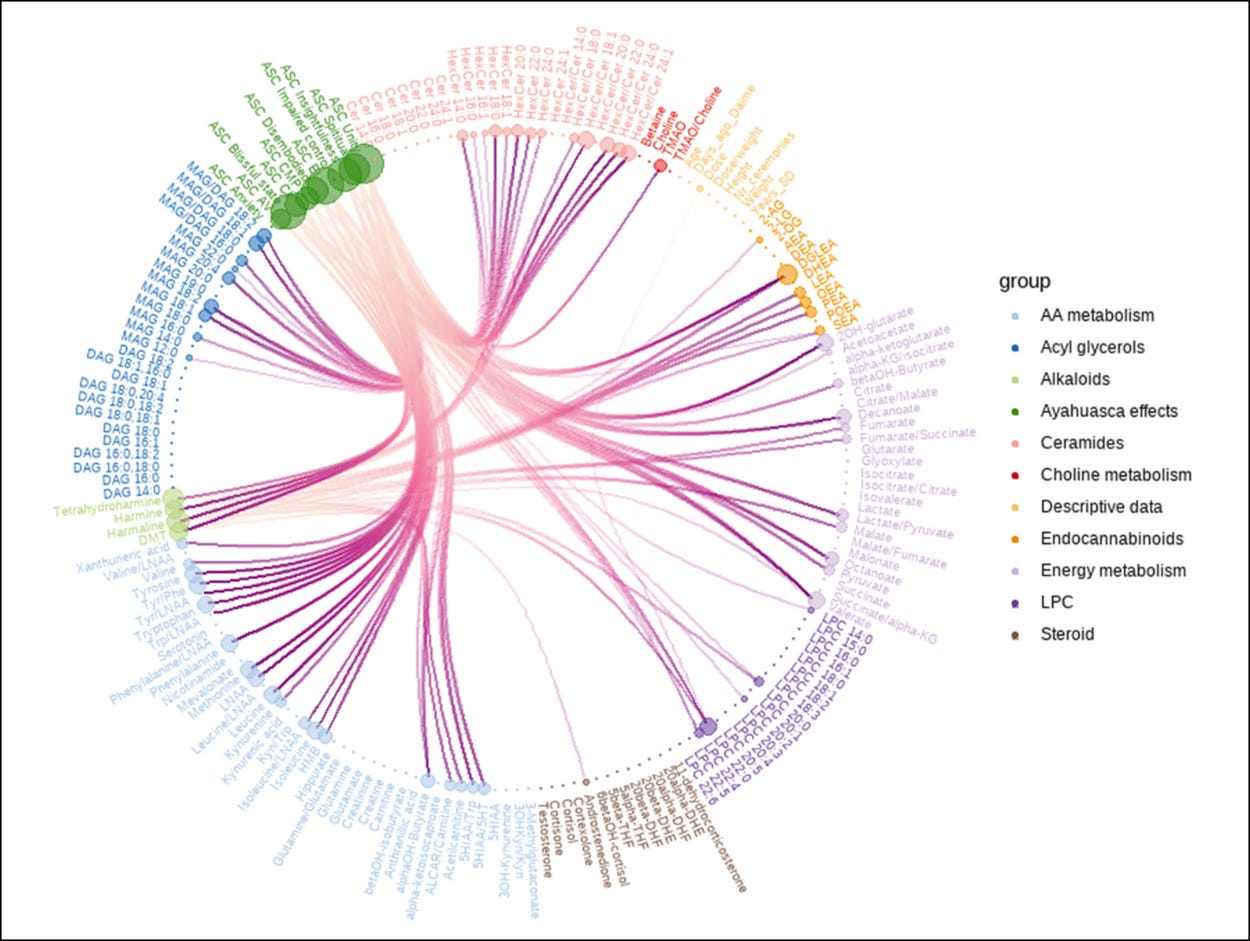Ayahuasca, metabolism, and consciousness
Madrid-Gambin et al. dives deep into the mind-body question
Few things before we begin:
Another long absence! Yes. Early Spring in Phoenix means I am collecting data from honeybee brains. I am aiming to get back on a monthly posting schedule, but bear with me until I finish this damn Ph.D. 😇
As always, follow me on Twitter @TyQuig and Instagram @thetab_psychedelicscience
Part of this newsletter is 24/7 office hours. If you have a question about psychedelic science, send it my way.
Aaaaaaand let’s go…
Metabolomics and integrated network analysis reveal roles of endocannabinoids and large neutral amino acid balance in the ayahuasca experience
Why they did it
Ayahuasca is a complex brew traditionally made from the DMT-containing leaves of Psychotria viridis and the beta-carboline-containing bark of Banisteriopsis caapi. 🍵
DMT cannot be orally consumed alone because our body has enzymes that tear up molecules with a single nitrogen group (i.e. DMT). These enzymes are called monoamine oxidases (MAOs) and help keep stuff like extra serotonin from oggling our brains.
beta-carbolines inhibit MAOs (MAOIs) ⛔️, which allow DMT to survive long enough to enter our brains.
A consequence of MAO inhibition is that all molecules with a single nitrogen can continue to circulate, including neurotransmitters such as serotonin.
DMT, beta-carbolines, and everything else not broken down by MAO’s potentially contributes to the subjective, therapeutic, and negative side effects of drankin’ brew.

The slew of chemicals and metabolites released into the body post-ayahuasca implies that it may imbalance our body’s entire metabolome.
A metabolome is the full suite of small biological molecules circulating in a biological sample🩸
In this study, the ayahuasca-addled metabolome tells a whole-body story of the biological processes altered by the psychedelic brew.
What they did
23 volunteers from the Dutch chapter of the Santo Daime church to participated in the study.
Blood samples were taken the day before to establish a baseline and 90 minutes after drinking ayahuasca.
These samples were tested for concentration of ayahuasca alkaloids and for 164 metabolites across multiple chemical classes.
Participants also completed the 5-Dimension Altered States of Consciousness psychological test at the end of their ayahuasca trip 🙇♀️
Psychological, metabolomic, and behavioral (ex. time since last consumption, years in Santo Daime) variables were plugged into a model to discover correlations between them.
These correlations were then used to build an integrative pathway network and a heat map (Figure 1). The former is a fancy way of saying grouping variables based on their correlation with other variables. The latter symbolizes significant relationships between the variables measured.
Finally, interesting metabolites were plugged into another software package that spits out relevant biological pathways related to the metabolites plugged in (Figure 2).

What they found
The overall metabolic signature of the ayahuasca experience is the alteration of (1) serotonin metabolism, (2) endocannabinoid levels, and (3) amino acid balance.
The alteration to serotonin metabolism is likely due to the MAO inhibition by beta-carbolines.
This can cause the accumulation of serotonin at nerve endings, resulting in serotonin syndrome 🤢
This inhibition is (obviously) associated with some of the subjective effects of ayahuasca.
Endocannabinoids are lipid-based signaling molecules found throughout the body and brain. They bind to cannabinoid receptors, the same ones to which THC binds 🍁
Ayahuasca has a notable effect on endocannabinoid levels outside of the brain.
Probably because beta-carbolines also inhibit an enzyme that breaks down endocannabinoids.
We know that the activation of 5HT2A receptors in the brain triggers a release of the endocannabinoid 2-AG, though there’s no word on how this effects levels outside of the brain.
Despite this, there was no correlation between endocannabinoids and subjective experience.
Probably because the brain is separated from the rest of the body, and so circulating levels of endocannabinoids may not influence levels in the brain.
On the other hand, they found a dysregulation of amino acids in circulation, which does have an impact on the brain.
Amino acids tryptophan and tyrosine are precursors to serotonin and dopamine, respectively.
They also compete for the same blood-brain barrier transporter 🤺
Together, this implies that more tryptophan and less in tyrosine will enter the brain, throwing off the normal serotonin:dopamine production ratio.
The correlations between the amino acid metabolites and subjective measures suggests this imbalance has an effect on the ayahuasca experience.
My Take
It is easy and elegant to describe the mechanism of a psychedelic as “molecule A binds to receptor B and then the universe unravels.” However, there really is much more to this picture. I chose this article because it expands this picture outside of the brain. The mystery of ayahuasca and its effect on consciousness exists in the body as much as the mind.
I think the tightest connection between body and mind that these researchers found is the dysregulation of amino acids in the blood samples from these recently tripping participants. Every molecule in the brain at some point came from outside of the brain. There is a constant stream of new molecules coming in, and none have such an impact on our conscious experience as neurotransmitters and their precursors. Ayahuasca not only presents DMT to the body and prevents it from breaking down, but also gives tryptophan (serotonin precursor) the upper edge to nudge past tyrosine at the door to the brain.
Our metabolic state fluctuates throughout the day, between meals, between exercise, etc. I would like to see more studies that examine how ayahuasca interacts with different baseline metabolic states in humans. This could give us valuable insight into “metabolic settings” which make for safer and more enjoyable ayahuasca experiences. For this reason, I believe there is a lot of value to whole-body approaches such as this one to understand the psychedelic experience.
We are continuing with ayahuasca next time with a new study on the impact of B. caapi components one of my favorite cells: microglia
I appreciate your feedback on how I did breaking down this science. Let me know in the comments:
Think more people should know about psychedelic science? Share my newsletter with your people, because your people are my people ✌🏽
📃 Here’s the paper:
Madrid-Gambin, F. et al. Metabolomics and integrated network analysis reveal roles of endocannabinoids and large neutral amino acid balance in the ayahuasca experience. Biomed. Pharmacother. 149, 112845 (2022).
Available here
From Around the Psychosphere
🔬 Research
Ido Hartogsohn’s opus on set and setting in the Santo Daime Church 🛐
Effect of B. caapi components on inflammatory action in microglia (focus of next journal club) 🧫
A new DMT light switch for exploring 5HT2A receptor function 🔦
Do mushrooms use words to communicate?
New Nature paper on effect of psilocybin on global integration, briefing here (email me if you need access), and discourse:


🔮 Culture
Cover Story: Power Trip has wrapped up, and the horrific tale it tells about psychedelic therapy and the power structures that turn a blind eye is haunting. If you are interested in anything psychedelic, add this to your knowledge about its dark side.
Explore this beautiful Erowid Visualizer.
On a personal note, please consider signing this petition, even if you have never or have no plans to see a show in Tempe. Money should not triumph over music and the arts.


📈 Industry
Numinus to acquire Novamind, expand into U.S.A.

Patent battles in psychedelics weather on 🌬
Yet stock prices in psychedelic companies continue to peter. 🤔
Tunes for your next flow state
In honor of Shady Park 🔥🔥🔥
🤟🏽 Have a swell weekend friends 👽






